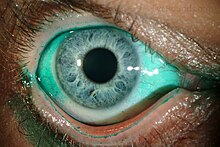User:Mr. Ibrahem/Dry eye syndrome
| Dry eye syndrome | |
|---|---|
| Other names | Dry eye, keratoconjunctivitis sicca, dry eye disease (DED), keratitis sicca |
 | |
| Diffuse lissamine green staining in a person with severe dry eye.[1] | |
| Specialty | Ophthalmology |
| Symptoms | Dry eyes, irritation, redness, discharge, blurred vision[2] |
| Complications | Corneal scarring[2] |
| Causes | Contact lenses, meibomian gland dysfunction, allergies, pregnancy, Sjögren syndrome, vitamin A deficiency, LASIK surgery, antihistamines, hormone replacement therapy, antidepressants[2][3][4] |
| Diagnostic method | Based on symptom[5] |
| Treatment | Artificial tears, wrap around glasses, changing certain medications[2] |
| Medication | Ciclosporin, steroid eye drops[2] |
| Frequency | ~20%[6] |
Dry eye syndrome (DES), also known as keratoconjunctivitis sicca (KCS), is the condition of having dry eyes.[2] Other associated symptoms include irritation, redness, discharge, and easily fatigued eyes. Blurred vision may also occur.[2] The symptoms can range from mild and occasional to severe and continuous.[3] Scarring of the cornea may occur in some cases without treatment.[2]
Dry eye occurs when either the eye does not produce enough tears or when the tears evaporate too quickly.[2] This can result from contact lens use, meibomian gland dysfunction, allergies, pregnancy, Sjögren syndrome, vitamin A deficiency, LASIK surgery, and certain medications such as antihistamines, some blood pressure medication, hormone replacement therapy, and antidepressants.[2][3][4] Chronic conjunctivitis such as from tobacco smoke exposure or infection may also lead to the condition.[2] Diagnosis is mostly based on the symptoms, though a number of other tests may be used.[5]
Treatment depends on the underlying cause.[2] Artificial tears are the usual first line treatment.[2] Wrap around glasses that fit close to the face may decrease tear evaporation.[2] Stopping or changing certain medications may help.[2] The medication ciclosporin or steroid eye drops may be used in some cases.[2] Another option is lacrimal plugs that prevent tears from draining from the surface of the eye.[2] Dry eye syndrome occasionally makes wearing contact lenses impossible.[2]
Dry eye syndrome is a common eye disease.[3] It affects 5–34% of people to some degree depending on the population looked at.[6] Among older people it affects up to 70%.[7] In China it affects about 17% of people.[8] The phrase "keratoconjunctivitis sicca" means "dryness of the cornea and conjunctiva" in Latin.[9]
References[edit]
- ^ Critser, Brice. "Lissamine green staining in keratoconjunctivitis sicca". Eye Rounds. The University of Iowa. Archived from the original on 7 August 2016. Retrieved 29 July 2016.
- ^ a b c d e f g h i j k l m n o p q r "Facts About Dry Eye". NEI. February 2013. Archived from the original on 28 July 2016. Retrieved 29 July 2016.
- ^ a b c d Kanellopoulos, AJ; Asimellis, G (2016). "In pursuit of objective dry eye screening clinical techniques". Eye and Vision. 3. London: 1. doi:10.1186/s40662-015-0032-4. PMC 4716631. PMID 26783543.
{{cite journal}}: CS1 maint: unflagged free DOI (link) - ^ a b Michelle Meadows (May–June 2005). "Dealing with Dry Eye". FDA Consumer Magazine. U.S. Food and Drug Administration. Archived from the original on February 23, 2008.
- ^ a b Tavares Fde, P; Fernandes, RS; Bernardes, TF; Bonfioli, AA; Soares, EJ (May 2010). "Dry eye disease". Seminars in Ophthalmology. 25 (3): 84–93. doi:10.3109/08820538.2010.488568. PMID 20590418.
- ^ a b Messmer, EM (30 January 2015). "The pathophysiology, diagnosis, and treatment of dry eye disease". Deutsches Ärzteblatt International. 112 (5): 71–81, quiz 82. doi:10.3238/arztebl.2015.0071. PMC 4335585. PMID 25686388.
- ^ Ding, J; Sullivan, DA (July 2012). "Aging and dry eye disease". Experimental Gerontology. 47 (7): 483–90. doi:10.1016/j.exger.2012.03.020. PMC 3368077. PMID 22569356.
- ^ Liu, NN; Liu, L; Li, J; Sun, YZ (2014). "Prevalence of and risk factors for dry eye symptom in mainland china: a systematic review and meta-analysis". Journal of Ophthalmology. 2014: 748654. doi:10.1155/2014/748654. PMC 4216702. PMID 25386359.
{{cite journal}}: CS1 maint: unflagged free DOI (link) - ^ Firestein, Gary S. (2013). Kelley's textbook of rheumatology (9th ed.). Philadelphia: Elsevier/Saunders. p. 1179. ISBN 978-1437717389. Archived from the original on 2017-09-08.
